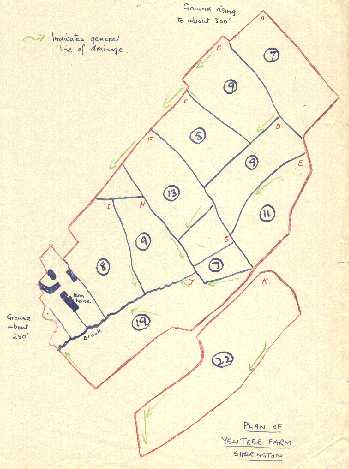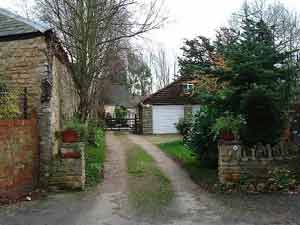This farm (see below for plan) is situated on the north-eastern boundary of the village of Sherington. It is a holding of over 120 acres and is occupied and worked by the owner -farmer. Yew Tree Farm is a compact farm, all fields are connected and radiate from the farmhouse itself. The house was built in 1597, the original portion showing the date, has two additions but as both of these wings were added a long time ago the character of the house is not spoiled. The building is of local limestone with a tiled roof.
In October 1958 there was a change of ownership Yew Tree Farm was offered for sale for £10,000 and sold readily. Before this date it had been a 'mixed farm', most of the land was under the plough but a dairy herd was also kept. The new owner dispensed with the dairy side of the business and devoted his entire attention to arable farming but he did retain one field of pasture which he is now beginning to stock. After the wet Summer of 1958 his first task was to get as much Autumn ploughing done as was possible and although he worked quickly and efficiently he did not achieve as much as he would have wished and some had to be left until the Spring. This factor influenced his choice of crops for the first season.
The plan below shows the general lay-out of the farm. Figures indicate the approximate acreage of each field.
1958 crop (if known) 1959 crop 1960 proposed crop Wheat (A) Spring barley Beans Oats (B) Spring barley Beans Corn crop (C) Winter wheat Oats lay (D) Lay (seeded 1 year lay) Winter wheat (E) Lay (temporary lay) Forage crop (F) Spring barley & temp lay Forage crop (G) Spring wheat Winter barley Pasture (H) Permanent pasture Permanent pasture Wheat, Kale (I) Spring barley, potatoes & Winter wheat Winter wheat Wheat (1st year Spring wheat Barley & peas ploughed) (J) (K) ½ fallow, ½ winter wheat The reverse of 1959 ½ wheat & barley & half fallow.
Over the entire farm there is heavy clay sub-soil with underlying rock of Dolictic Limestone. The top-soil is variable.

- Fields A.B.C.D.& E. have thin covering. The ploughing of this Autumn (1959), which seems to be deeper than that of past years is turning up yellowish clay.
- Field D. is peculiar in that the top-soil is of a reddish brown colour. I think this is a feature found elsewhere on a limestone base.
- Fields F.G.H.& I. have a good covering of loam which increases in depth as it nears the farm house.
- J. varies from a good loam to a very sandy soil towards its boundary.
- K. is a field of heavy clay. Half was left fallow during 1959 and was 'mole drained. It was then set with a mustard crop, the plan being to plough the mustard in for manure, but the dry Summer prevented this and eventually a flock of sheep were allowed to eat off the mustard. This half is now ploughed however and a crop of winter barley is already in it. The other half of the field is to remain fallow for 1960 for this to be drained in a similar way.
- Field J. is badly drained in places ; the farmer has himself put in some field drains but there is a more extensive of drainage, (which will earn a government grant) under consideration.
In general the 1959 crop was satisfactory. In C. the wheat crop was poor, mainly due to the presence of 'twitch grass'. This is now killed (it is hoped) by ploughing up, drying out by the sun, and ploughing again. In field I the quality of the barley was poor owing to the late sowing. The inside of the grain was a greyish colour instead of white, and of a flinty texture. This would be sold for cattle food. The actual yield off that portion of the field was good, in spite of late sowing; there were three tons from 2 ½ acres. The potatoes yielded well but the skins had a scabby appearance. This has not yet affected their keeping quality though, but as they were main crop potatoes (Majestic) they should keep through-out the Winter.
The farmer has chosen to follow his crops with beans in those fields where he knows that there have been two white straw crops already, in succession, and maybe even a third. Field J. was permanent pasture prior to 1958 and for as long back as can be remembered. I. was in 1957 and carried a mangold crop but was pasture also, before that date. In each of these fields the soil is sufficiently rich to carry a straw crop for several more years successfully, if it were so wished. As barley will probably flatten in so rich a soil, a crop of wheat or peas is preferable. The stubble has been burned off these fields during the Autumn to kill any disease which would carry over.
Where manure is necessary it will be provided mainly by an artificial, or a green crop. There has been of a soil test for adding lime but there is no factor to indicate that this is really necessary. I would think that there is sufficient lime in the soil at the moment especially where the top-soil is deep. The soil is considered to be suitable for all crops providing they are grown in rotation.
There are two firms of cereal merchants in Newport Pagnell: Messrs Coales and Price. Both firms purchase grain from the local farmers and re-sell to maltsers or flour merchants. Messrs Coales hold the lease of the water mill at Olney where the poorer quality barley is milled for cattle food and some is mixed with molasses for manufacture of poultry pellets. Both firms retail cattle food and seed throughout this area. After the harvest the farmer submits a sample of grain to the merchants, who, after inspection, will purchase the product of the field. Barley prices range from 17/- to 20/- per cwt. wheat is priced at 26/6 per cwt. but this price includes a subsidy. A barley subsidy is paid upon the acreage grown, not on the cwt. price.
Hay or straw is sold privately, from farmer to user. The hay crop from Yew Tree Farm was good this year, certainly above average for the neighbourhood. A good part of the crop was sold when mowed, in one case the entire field; I think the price was £8-0 per ton. The farmer has kept back one rick for his own use but he still has some left from 1958. When the hay was cut it was piled into haycocks, a method which is not usual in this neighbourhood. Most farmers mow, turn, then bale their hay trusting in fine weather prevailing throughout the operation. The farmer told me that the haycock method helps to retain the green colour of the hay and lessens any loss of quality should the weather become wet.
Field H. which is permanent pasture is now lightly stocked with 4 young beef cattle and 56 sheep. The pasture is of medium quality and will later be used for a larger number of young cattle. The sheep are to be kept only throughout the Winter. They were purchased in Scotland by local farmer who went to buy for himself and for several other people at the same time. The flock was sent by train to Wolverton Station and then on to the village by road transport.
Poultry kept on the farm include 100 laying hens, 8 cockerels and 6 geese; the cockerels and geese will be sold at Christmas. There were 24 Aylesbury ducks during the Summer. These were reared to 12 weeks and 15 weeks ( ½ each) and sold for the table. All the poultry has free range around the farmyard and orchard. The hens are mainly Hampshire Red / Light Sussex and the eggs are collected every Monday by one of a number of vans which serve the area and deliver to a depot in Leighton Buzzard.
The principle pests to farmers locally are hares and wood pidgeons. These are dealt with shooting or snaring. There has been a resident cock pheasant with his family throughout this year in one of the fields near the farmhouse.
The farmer employs one regular labourer, who with his wife as housekeeper, is resident in the farmhouse (the farmer is unmarried). These two men do the main part of the farm work. A little extra help was brought in at harvest time and the straw was baled and collected by another farmer who owned a baler. It was agreed that for baling two fields he could take for himself the straw from one. There is a good supply of modern machinery in use on the farm including a crawler tractor, a wheel tractor and a combine harvester. Without such machinery I am sure it would not be possible to work such an acreage with only two men.
It is possible to obtain all the machinery required within the neighbourhood. W.J.Cooper, of Newport Pagnell offers for sale a variety of machinery and will quickly obtain any that is not in stock. He is a Fordson agent and has a small factory behind his showroom in which 4 wheel and 2 wheel trailers, wheel barrows, sheep racks and some rubber goods are manufactured. He has other depots at Gt. Linford and Buckingham.
W. Rogers of Sherington and Gt. Barford (Beds) offers a similar stock and is a Massey - Fergussen agent. Both firms undertake all servicing needs. These two, together with Sowmans of Olney, a large iron-monger and horticultural merchant, supply the whole area north of Bletchley.
Additional Notes:

Coopers of Newport Pagnell had their showrooms on the main road on the site of the doctors surgery & health centre, with their workshops at the rear. Latterly this became a Peugeot car showroom, before finally closing in the 1990s.
W. Rogers was situated on the site now occupied by Maryot Close, Sherington, after over 40 years of trading these premises closed in 1994.
Sowmans ironmongers of Olney, I have little knowledge of this company. Except that there are many examples of their iron-mongery goods scattered around Sherington in the form of drain grills & manhole covers, with their name cast on them.
Coales & Price, both gone from the area, both mills now closed. Although the mill stream at Olney is still there, and can be seen from the bridge over the Ouse.
The article above is taken from Memories of Sherington by Doris Stephens, nd was written in 1959/60, SHS.
Grade 2 Listed Building
On 27 February 1984, Yew Tree Farmhouse was included in the Department of the Environment's List of Buildings of Special Architectural or Historic Interest for the District of Milton Keynes under Section 54 of the Town and Country Planning Act 1971.
Yew Tree Farmhouse is also listed in 'An Inventory of the Historical Monuments in Buckinghamshire, Volume Two' by the Royal Commission on Historical Monuments (England), 1913, where it is Monument No. 3.
Archive photographs of Yew Tree Farm: click on the photo to view full size






